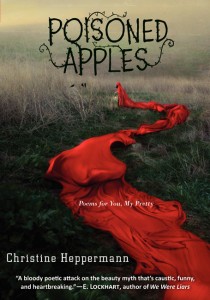Poisoned Apples
 Poisoned Apples, Christine Heppermann
Poisoned Apples, Christine Heppermann
Greenwillow, October 2014
Reviewed from ARC
Gosh, it’s a good year for poetry, at least from a publishing perspective.
And unlike Nelson’s gorgeous memoir that I will be hard pressed to sell to actual real live teen readers™, Poisoned Apples has appeal in spades.
This was a later addition to our list, thanks to buzz and three stars, and I’m glad we didn’t miss it; it’s a small collection of woman-centric fairy-tale poems that recast the action in the schools and streets and bedrooms and bathrooms of today’s world. Sort of Anne Sexton lite, maybe — which, frankly, is pretty much everything wrong with this collection in a nutshell.
Then again, when I was in grad school and we had to create a core collection on a topic of our choosing, I chose fairy tales and retellings, so maybe it’s only me who feels been there, done that? Or does it even matter? Originality isn’t necessary, after all (although I’ve always believed that a fresh look is important, and that’s what I don’t see here. And some of the poems are great pieces of writing and worth recognizing for their literary chops, separate from content; they’re unrhymed verse, with differing structures, most some form of free verse rather than anything more formal as far as I can tell (although the lack of rhyme scheme might have blinded me to some poetic constructs).
On the amazing side, let me share with you “Photoshopped Poem”, which manages to be funny and spare and full of social commentary; it’s also less fairy tale themed than most of the collection, although right on target with the secondary theme of eating disorders and the issues surrounding female body image and media representations of the female body:
Some say the Before poem
had character.
This poem is much more attractive.
With the Healing Brush Tool
I took out most of the lines.
I left in a few
so it wouldn’t look unnatural.
The subthemes come across heavily when the collection is read start to finish, especially the eating disorder part of it — there were some moments when the message shadowed the writing; some of that is also the fault of poem order, which is mostly but not always on target. Will the RealCommittee see the lack of subtlety as a flaw? Or is it that this is a collection better waded in and out of than gulped down in a single sitting?
If the writing is a pro, most of the time, and the overt (if sometimes uneven) messaging is a con, the tie breaker might be the design. I haven’t seen the final version yet, but even in advance copy the design is a stunner, from that gorgeously evocative cover to that prickly title font to the haunting photos. It’s a lot of design and it enhances the work significantly — the illustration on “BFF,” which is about the worst kind of toxic friendship, somehow made the Jack and Jill reference that I think the reader is meant to get (the narrator’s name is Jill) pop out in a way that the poem alone hadn’t done for me, and there’s an image (on a secondary title page just past the table of contents, preceding the bulk of the text) of a blindfolded girl eating apples hung from a tree that both stuck with me and played perfectly against all the images of starvation and food restriction as well as the Eve reference in “The First Anorexic,” which marries anorexia to punishment for Eve’s sin — a poem, I should mention, that I find uncomfortable and which I think belies some of the feminist underpinnings of the collection, but also one that has continued to haunt me. (I’ve embedded a clip below, courtesy of the Harper website, so you can get a sense of the design, including the photo in question, and even two of the poems — none of the ones I’ve discussed, though — in case you haven’t seen this one yet.)
Mostly, I am saying that I am conflicted. If I were at the table, I wouldn’t be pushing for this one — but I’d listen very closely if someone else did.
RELATED
The job outlook in 2030: Librarians will be in demand
The job outlook in 2030: Librarians will be in demand
ALREADY A SUBSCRIBER? LOG IN
We are currently offering this content for free. Sign up now to activate your personal profile, where you can save articles for future viewing






Add Comment :-
Be the first reader to comment.
Comment Policy:
Comment should not be empty !!!